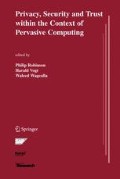Abstract
Having considered adaptation and usability as two major challenges for security in pervasive computing, this paper presents an architecture and protocol to address the associated challenges. The major challenges specified are resource modeling, context-awareness, adaptive control and dynamic interaction. With an operation-centric approach, a dual-controller architecture is presented and a coordination protocol specified.
Access this chapter
Tax calculation will be finalised at checkout
Purchases are for personal use only
Preview
Unable to display preview. Download preview PDF.
References
J. Barwise and J. Perry. Situations and Attitudes. MIT Press, Cambridge, MA, 1983.
M. J. Covington, P. Fogla, Z. Zhan, and M. Ahamad. A Context-aware Security Architecture for Emerging Applications. In Annual Computer Security Applications Conference (ACSAC), 2002.
Anind K. Dey. Understanding and Using Context. Personal and Ubiquitous Computing Journal, 5(l):4–7, 2001.
D. Hutter, W. Stephan, and M. Ullmann. Security and Privacy in Pervasive Computing: State of the Art and Future Directions. In First International Conference on Security in Pervasive Computing. Springer, 2003.
Tim Kindberg, Kan Zhang, and Narendar Shankar. Context authentication using constrained channels. In WMCSA, 2002.
Patrick McDaniel. On context in authorization policy. In 8th ACM symposium on Access control models and technologies, 2003.
Ghita Kouadri Mostfaoui and Patrick Brzillon. A Generic Framework for Context-Based Distributed Authorizations, 2003.
Brian Noble and Mark Corner. The case for transient authentication. In 10th ACM SIGOPS European Workshop, 2002.
Johannes Petersen. Modelling Control Situations for the Design of Context Sensitive Human-Machine Systems. In 21st conference on Human Decision Making and Control, 2002.
William T. Powers. A Brief Introduction to Perceptual Control Theory. Copyright 2003 William T. Powers.
Philip Robinson and Michael Beigl. Trust Context Spaces: An Infrastructure for Pervasive Security. In First International Conference on Security in Pervasive Computing. Springer Verlag Press, 2003.
David Scott, Alastair Beresford, and Alan Mycroft. Spatial Policies for Sentient Mobile Applications. In The 4th International Workshop on Policies for Distributed Systems and Networks, pages 147–157. IEEE Policy, 2003.
Gyula Simon, Tarns Kovcshzy, and Gbor Pceli. Transient Management in Reconfigurable Control Systems. Technical report, Budapest University of Technology and Economics, 2002.
M. S. Sloman. Policy driven management for distributed systems. Journal of Network and Systems Management, 2(4):333–360, 1994.
F. Stajano. The Resurrecting Duckling — what next? In The 8th International Workshop on Security Protocols, April 2000.
Erkan Tin and Varol Akman. Computational Situation Theory. SIGART Bulletin, 5(4):4–17, 1994.
Albert van Breemen and Theo de Vries. An Agent-Based Framework for Designing Multi-Controller Systems. In Fifth International Conference on The Practical Applications of Intelligent Agents and Multi-Agent Technology, 2000.
X. H. Wang, D. Q. Zhang, T. Gu, and H. K. Pung. Ontology based context modeling and reasoning using OWL. In Workshop on Context Modeling and Reasoning at 2nd IEEE International PerCom, 2004.
Ka-Ping Yee. User Interaction Design for Secure Systems. Technical Report CSD-02-1184, University of California Berkeley, May 2002.
Guangsen Zhang and Manish Parashar. Context-aware Dynamic Access Control for Pervasive Applications. In Communication Networks and Distributed Systems Modeling and Simulation Conference (CNDS), 2004.
Author information
Authors and Affiliations
Editor information
Editors and Affiliations
Rights and permissions
Copyright information
© 2005 Springer Science+Business Media, Inc.
About this chapter
Cite this chapter
Robinson, P. (2005). Architecture and Protocol for Authorized Transient Control. In: Robinson, P., Vogt, H., Wagealla, W. (eds) Privacy, Security and Trust within the Context of Pervasive Computing. The International Series in Engineering and Computer Science, vol 780. Springer, Boston, MA. https://doi.org/10.1007/0-387-23462-4_13
Download citation
DOI: https://doi.org/10.1007/0-387-23462-4_13
Publisher Name: Springer, Boston, MA
Print ISBN: 978-0-387-23461-8
Online ISBN: 978-0-387-23462-5
eBook Packages: Computer ScienceComputer Science (R0)

